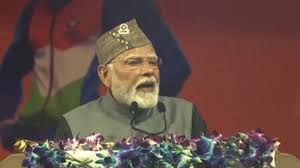India’s Largest Tribal Empowerment Drive Underway
By admin | 26-05-25
NEW DELHI, June 26, 2025 – In an unprecedented and monumental effort to uplift tribal communities across the nation, the Ministry of Tribal Affairs has launched the “Dharti Aaba Janbhagidari Abhiyan (DAJA).” This month-long, nationwide campaign, named in honor of the revered tribal freedom fighter Bhagwan Birsa Munda, aims to ensure saturation of government welfare schemes and foster holistic development in over 1 lakh tribal villages across 31 States and Union Territories.
The DAJA campaign, which commenced on June 15 and will run until July 15, 2025, is being hailed as the largest tribal outreach and empowerment initiative in independent India’s history. Its core objective is to bring government services and entitlements directly to the doorsteps of over 5.5 crore tribal citizens, including those residing in remote and Particularly Vulnerable Tribal Group (PVTG) habitations.
“This is not merely a campaign; it is a mass movement for dignity, inclusion, and respect,” stated a spokesperson from the Ministry of Tribal Affairs. “By placing tribal voices at the center of this initiative, we are reaffirming our commitment to the vision of ‘Sabka Saath, Sabka Vikas, Sabka Vishwas, Sabka Prayas’ and building a truly Viksit Bharat.”
Over 275 special camps will be held with the twin goal of spotlighting eligible beneficiaries and ensuring their inclusion in 35+ central and state welfare schemes. Services will cover everything from Aadhaar and ration card issuance, Ayushman Bharat health cards, PM‑Jan Dhan accounts, PM‑KISAN, Pradhan Mantri Janjatiya Nyaya Maha Abhiyaan (PM‑JANMAN), to Mahatma Gandhi National Rural Employment Guarantee Act (MGNREGA) benefits, insurance under PMJJBY/PMSBY, along with programmes focused on women, children, livelihoods, and social security.
At the flagging-off ceremony, Union Joint Secretary for Tribal Affairs, Brijnandan Prasad, emphasized the need to include previously excluded tribal families and prioritize “last-mile” delivery. District Commissioner Karn Satyarthi echoed this, stressing on-site registrations and robust participation
What is DAJA?
Part of the central Janjatiya Gaurav Varsh celebrations, DAJA is a two-week blitz featuring “awareness and benefit saturation camps” in tribal and PVTG (Particularly Vulnerable Tribal Group) areas. Similar campaigns are underway in regions like Kargil, Shopian, Srinagar, and Chhattisgarh, aiming to close coverage gaps and ensure direct delivery of welfare entitlements to indigenous communities.
The Abhiyan operates on a robust, community-driven model, actively involving district administrations, youth volunteers, civil society organizations (CSOs), and tribal leaders. It is underpinned by five key pillars:
- Janbhagidari (People’s Participation): Empowering tribal voices and ensuring community-led governance.
- Saturation: Achieving 100% coverage of eligible households under various central government schemes.
- Cultural Inclusion: Integrating tribal languages, arts, traditions, and cultural symbols to ensure dignity and identity.
- Convergence: Fostering seamless coordination among multiple ministries, CSOs, and youth groups for integrated service delivery.
- Last-Mile Delivery: Ensuring direct and efficient delivery of services to the remotest tribal hamlets.
Early reports indicate significant progress in the first nine days of the campaign, with over 53 lakh tribal citizens already reached through 22,000+ camps. Impressive outcomes include:
- Over 1.38 lakh Aadhaar enrolments facilitated.
- More than 1.68 lakh Ayushman Bharat cards issued.
- Over 46,000 tribal farmers registered under PM-Kisan.
- 22,000+ women enrolled under PM Ujjwala Yojana.
- 32,000+ new PM Jan Dhan accounts opened.
Beyond direct welfare delivery, the DAJA campaign holds a strong cultural emphasis. It is an integral part of the “Janjatiya Gaurav Varsh” (Tribal Pride Year), a year-long celebration from November 15, 2024, to November 15, 2025, honoring tribal pride, identity, and progress. Village-level camps are also hosting cultural programs, showcasing tribal cuisine, folk dances, and handicraft exhibitions to revive and celebrate indigenous heritage.
Why It Matters
- Closing equity gaps: Many tribal households remain unconnected to essential schemes due to documentation, awareness, or remoteness.
- One-stop distribution: Camps offer a unified venue for multiple services—eliminating bureaucratic hurdles.
- Participatory governance: The term “Janbhagidari” (public participation) underscores inclusive grassroots engagement.
The Ministry of Tribal Affairs has urged all citizens, academics, volunteers, and media platforms to actively participate in and amplify this transformative movement. The Dharti Aaba Janbhagidari Abhiyan is poised to be a landmark step towards bridging developmental gaps, promoting participatory governance, and ensuring that no tribal household is left behind on India’s path to prosperity.
With DAJA nearing midway, district administrators will be reviewing camp impact, beneficiary numbers, and service delivery metrics. The campaign is also a litmus test for the upcoming rollout of further tribal development schemes nationwide.
By ensuring wider scheme uptake and local ownership, DAJA aims to ensure that no deserving tribal family is left behind—transforming policy intent into tangible grassroots outcomes.



